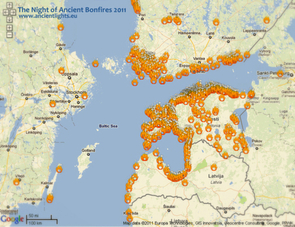Written 2010, before event: Hundreds of Bonfires to be Lit on Estonian Coastline for Night of Ancient Bonfires
28 August 2010 (BNS)
This is the second time Estonians calls for the people to take part in the event Night of Ancient Bonfires. Organizers have called for the fires to be lit at 8:30 p.m.
Estonian time.
For the second time in a row
Estonia will be taking part in the Night of Ancient Bonfires initiative,
during which people are invited to light a bonfire or a candle on the
coast of the Baltic Sea on the night of the last Saturday of August.
The goal is to cover the coastline with bonfires in such way that from
each place at least two other fires can be seen.
In 2009, the first time the whole Estonian people took part in the tradition that got its start in Finland and Hiiumaa 1992, hundreds of bonfires were lit along the Estonian coastline.
As of 2 p.m. on Saturday, 223 bonfires and 12310 participants had been
registered on the event's Estonian
website. A map on the website shows
the coastlines of Harju County, which includes the capital Tallinn, and
of Pärnu County in southwestern Estonia as getting the greatest number
of fires. Fires are also to be lit on lakesides in places situated as
far from the sea as Kallaste, Põlva, Elva and Otepää.
A post on the website says that on the isle of Keri, which has no trees
and to where transportation of firewood is complicated, a group of
people will illuminate the local lighthouse, the oldest in the Gulf of
Finland, with flashlights during the whole night.
The Night of Ancient Bonfires was originally an initiative to mark the
75th independence anniversary of Finland in 1992, also invited some friends in Estonian islands. In the years after
that it lived on, especially in the archipelago of southwestern Finland,
as a local and communal farewell to summer. By now the tradition has
spread to all countries situated on the Baltic Sea and its goal is to
show the unity of coastal people and pay tribute to history and cultural
heritage.
In ancient times bonfires along the Baltic coast were lit to warn of
dangers. The earliest written reports of conveying messages by means of
bonfires date from the time of the Vikings, when a united system of
warning extended from the sea to the inland. Each community was under
obligation to make its contribution to the system by lighting and
keeping a bonfire, and strict punishment was applied for not fulfilling
the duty.



